Performance Improvement Plans are a popular and often powerful tool in helping address and potentially improve employee performance issues.
But, their purpose is often prone to misinterpretation.
Here’s everything both the companies issuing Performance Improvement Plans and the employees going through them need to know about this formal document.
Table of Contents
The introduction to Performance Improvement Plans (PIPs)
First things first: Let’s see what a Performance Improvement Plan (PIP) is, how it works, and how long it usually lasts.
What is a Performance Improvement Plan?
According to the definition, a Performance Improvement Plan, or a Performance Action Plan, is a formal document provided to an individual employee who is experiencing performance issues at work.
The purpose of the PIP is to help improve the said performance issues of an individual. Improving the performance of an existing employee is a less costly solution than looking for a replacement for the said employee – in that sense, a PIP can benefit both the employee undergoing it and the company implementing it. The additional, underlying purpose is to help improve the working of the entire workforce – considering that an efficient workforce is only possible with efficient individuals.
In order to help improve the individual employee’s performance, a Performance Improvement Plan provides:
- the goals the employee is tasked with achieving
- the tasks meant to help guide the employee toward the said goals
- the time he or she has to achieve the goals
How does a Performance Improvement Plan work?
From the point of view of the employee, a Performance Improvement Plan is meant to address his or her performance issues and help them overcome the said issues. In that sense, it’s similar to being on probation work.
Let’s call the employee Emily.
First, Emily’s employer and an HR representative meet up with Emily and explain to her the performance issue they noticed she’s been having.
They explain to her the goals she needs to reach in order to improve her performance and the time period she’ll have at her disposal for this purpose.
She’s then given the goal-related tasks she’ll need to tackle during this time, and the resources she’ll have at her disposal to do it.
She may have further questions about her position and the duties covered by the Performance Improvement Plan, and she can ask them at this meeting. If Emily agrees to participate in her proposed PIP, she needs to sign the formal document.
Emily is closely watched during this time period – she has frequent check-ups with her assigned supervisor, who monitors her progress.
Unless she is able to carry out her tasks and reach her goals during this time, her position at the company is further discussed — as the end result of an unsatisfactory PIP, she may be fired.
How long should a performance improvement plan last?
The time frame for a Performance Improvement Plan is usually between 30 and 120 days.
This usually depends on the type of performance issue(s), and how much time Emily will really need to improve her performance on the said issue(s).
Quick PIP guide for employers
There are several important points employers need to consider when implementing a Performance Improvement Plan with an employee.
Namely, when to use them, what types of PIPs there are, how to write and implement a PIP, and how you know your PIP has been effective.
When to use a Performance Improvement Plan?
Now, by definition, a Performance Improvement Plan is used to help improve the performance of an underperforming employee.
But what does that even mean? What are performance improvement issues? And when is a Performance Improvement Plan appropriate?
Well, it may be appropriate when:
- An employee working as a sales agent fails to reach a certain monthly quota, a significant number of times per month.
- An employee fails to complete a project on time, a significant number of times in a row.
- An employee fails to come to work on time, a significant number of times in a row.
- An employee fails to adhere to important company policy, once, or a significant number of times in a row.
- An employee fails to provide correct research data for projects, a significant number of times in a row.
Each of the listed situations may merit a suitable Performance Improvement Plan.
What types of Performance Improvement Plans are there?
Performance Improvement Plan for attendance
The area in which the employee (let’s once again call her Emily) is underperforming may be attendance.
For example, in the last couple of months, Emily has failed to get to work a couple of times, but she also failed to call in at the office within a reasonable time. She may have also made it a habit to be late to work on a regular basis.
You’ll need to make sure your Performance Improvement Plan covers all of Emily’s attendance issues, within a reasonable time period –say, 30 days.
Before implementing a Performance Improvement Plan for attendance – check whether the problem is on your end:
- Do you have an official employee attendance policy?
- Is your employee attendance policy clear?
- Are you providing incentives for good attendance behavior?
- Have you defined the consequences for subpar attendance?
Performance Improvement Plan for time management and productivity
The area in which Emily is underperforming may be tied to time management and productivity.
For example, in the last couple of weeks, Emily has constantly been behind with his work. As a result of her lackluster performance, her team has missed several moderately important project deadlines during one month.
You’ll need to make sure your Performance Improvement Plan covers all of Emily’s time management and productivity issues, within a reasonable time period –say, 60 days.
Before implementing a Performance Improvement Plan for time management and productivity – check whether the problem is on your end:
- Are project deadlines always clear?
- Is the scope of the work always clear?
- Is the requested work norm per day or week always clear?
- Do you have detailed and clear project timelines?
Performance Improvement Plan for teamwork
The area in which Emily is underperforming may be tied to the work she’s handling within a team.
For example, in the last couple of projects, Emily has remained on par with her work. However, her professional relationship with her teammates was less than great. She was often reluctant to take on responsibility for her actions, and reluctant to take extra work when needed. She was defensive in the face of constructive criticism and failed to make the requested changes. She failed to collaborate with her teammates in an efficient manner. As a result of all that, the final project had some shortcomings that could have been avoided.
You’ll need to make sure your Performance Improvement Plan covers all of Emily’s teamwork issues, within a reasonable time period –say, 90 days.
Before implementing a Performance Improvement Plan for teamwork – check whether the problem is on your (or someone else’s) end:
- Are the teams assembled carefully? Or do some team members lack the necessary interpersonal and technical skills to carry out their roles with success?
- Are the team responsibilities always clear?
- Does the team have all the necessary resources to carry out the work?
- Is the manager open for discussions with individual team members?
General Performance Improvement Plan
Sometimes, there’s not just one area of work Emily is underperforming in.
For example, she may be a lackluster team player, late at work, and/or late with projects. However, the intensity of her performance issues is low, this is her first job, and her hard skills are generally great, so you don’t want to fire her just yet. At least not without giving her a proper chance to improve.
You’ll need to make sure your Performance Improvement Plan covers all of Emily’s general performance issues, within a reasonable time period –say, 120 days.
But, before implementing a General Performance Improvement Plan – check whether you’re guilty of some of the above-listed problems that may be hindering Emily’s performance and stopping her from reaching her full potential.
How to write and implement a performance improvement plan?
Once you’ve determined that a PIP is appropriate for the Emilys of your company, it’s time to create a comprehensive Performance Improvement Plan.
There are several steps you need to follow in order to do so:
1. Create a Draft PIP
You may implement a PIP for different reasons, as previously mentioned, but you’ll always need to add several specific elements to your Performance Improvement Plan:
- Add “Employee information”
Here, you’ll add the basic information of your employee, their position at the company, their department, and the manager. You’ll also add the date when the employee signs the PIP – this formal document will come into motion on that date.

- Add “The Main Areas of Concerns”
Here, you’ll define the specific areas where the employee has thus far failed to meet the required expectations at work. As implied earlier, The Main Areas of Concern may be tied to attendance, time management, and productivity, teamwork, or a combination of several of these areas.
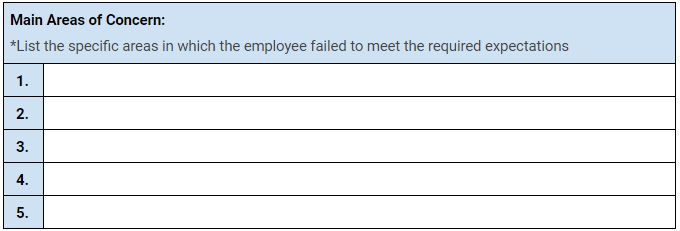
- Add “The Expected Consequences”
Here, you’ll define the consequences that await the employee if he or she does not live up to the requested goals to the fullest.

- Add “Expected PIP Duration”
This is one of the crucial elements of your PIP. The expected duration period of the PIP gives the employee the timeframe needed to reach the goals, and is crucial for the employee to organize resources available, and allocate specific time slots to tasks.

- Add “Issues Previously Addressed”
If you haven’t addressed this performance issue beforehand, it may be a bit extreme to open the issue with a Performance Improvement Plan. Before implementing a PIP, you’ll need to make sure you have made previous, less drastic attempts to encourage the employee to improve performance at work. These include all notable discussions, observations, and training the manager had with the employee on the topic.
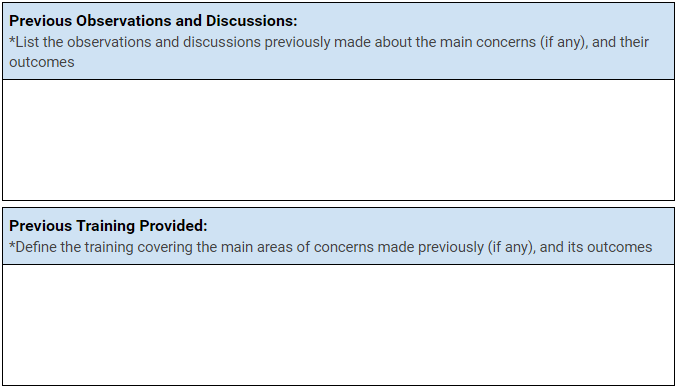
- Define “The Improvement Goals”
Here, you’ll define the specific goals the employee needs to reach within the time frame provided. If the issue you’re looking to correct is tied to time management, then one of the improvement goals you define may be for the employee to beat each project deadline they’re given.
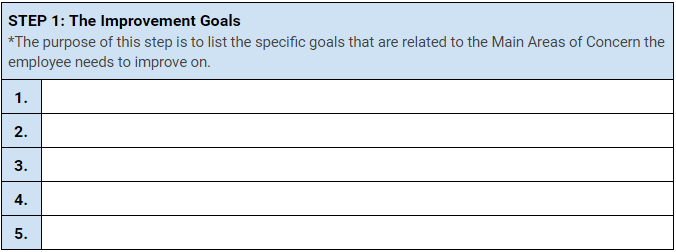
- Define “The Goal-Related Activities”
Goals are the main lodestar on the employee road to improved performance – but, he or she will need the goal divided into actionable tasks and activities.
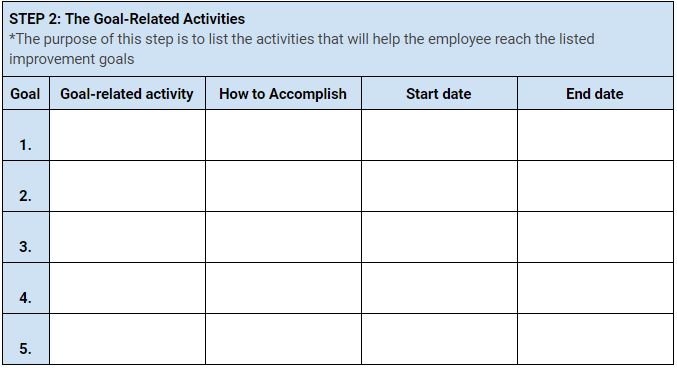
- List “The Resources”
Here, you’ll list the resources the employee has at disposal to tackle the tasks and strive towards goals. You may include books and specific help from the manager in the list of available resources.

- Define “The Expectations”
The expectations in a PIP plan serve as a point of reference – they explain the parameters that mark that the employee has reached the expected outcomes.
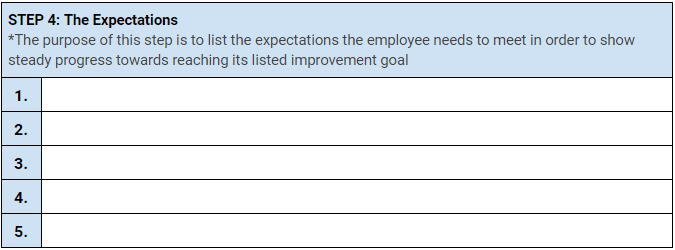
2. Review the PIP
When defining the goals, and goal-related tasks, or deciding on the time frame expected for the implementation of the Performance Improvement Plan, make sure you discuss these points with the employee first.
After all, if you’re already going through the trouble of defining a Performance Improvement Plan, you’ll want to set reasonable, attainable goals. Otherwise, you’ll be setting up your employee for failure.
So, before making anything official or asking the employee to sign anything, discuss the main points of the PIP first. Make changes as agreed upon.
3. Monitor the progress of the PIP
Once everything has been agreed upon with the employee, from here on, you’ll be tracking their progress. Each of the defined goal-related activities will need to be checked for progress on a regular basis. Decide on the dates when the progress checks will occur. Then decide on the follow-up methods and the people who will be carrying out the said follow-ups. You’ll also need to define the expected progress for each check-up point – to serve as a reference point to help you make conclusions.
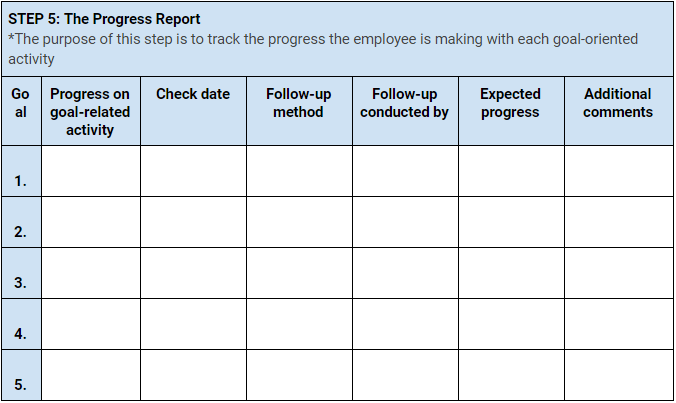
4. Make PIP conclusions
In the end, it’s time to make the conclusions:
Has the Performance Improvement Plan been successful?
Has the employee worked on and improved his or her performance issue? If not, you may need to terminate the position. If yes, it’ll mean continued employment.
Now, if the employee exceeded expectations, you may even want to give out a salary increase, to encourage the employee to continue with the said exceptional performance.
What’s an easy way to create a Performance Improvement Plan?
Knowing how to create a Performance Improvement Plan is useful, as you’ll know how to tweak it to fit your needs. However, as most efficient PIPs include the same elements, it’s much easier and faster to use a ready-made template.
Here’s an efficient one you download now for free:
🔽 DOWNLOAD Performance improvement plan template
With this PIP template, you can:
- use it for real-time editing in Google Docs — Just, click on “File” in the menu, click on “Make a Copy”, and name your new PIP document before saving it for further online editing. You can then easily share it with your employee to read and sign.
- download it as a Microsoft Word document and then edit further — Just, click on “File” in the main menu, select “Download”, and then click on “Microsoft Word(.docx)”.
- download it as a PDF document for easy printing — Just, click on “File” in the main menu, select “Download”, and then click on “PDF document(.pdf)”.
Are performance improvement plans effective?
Whether a Performance Improvement Plan is effective or not depends on the person who wrote it, and your intentions as an employee.
If your intentions adhered to the definition of a Performance Improvement Plan and involved the effort to actually help improve the performance of an employee by setting relevant, but attainable goals and obligations, then you have an effective PIP either way.
Speaking of “either way”, you may expect two outcomes from your effective PIP:
- The employee reached the requested goals in the prescribed time frame
- The employee didn’t reach the requested goals in the prescribed time frame, either out of lack of skills or will
Now, as previously mentioned, the first outcome indicates a successful Performance Improvement Plan. Yet, both outcomes can be viewed as effective, because they tell you whether the employee is a good fit for the standards in your company, or not.
Quick PIP guide for employees
Is a Performance Improvement Plan a disciplinary action?
In short, a Performance Improvement Plan is NOT a disciplinary action.
But, both a PIP and a disciplinary action come into play when an employee is somehow underperforming at work – the purpose of both is to address the performance issue and encourage the employee to make improvements. But, they have different tactics to achieve their ends.
Now, a Performance Improvement Plan involves concrete goals and a specified time frame that helps lay out the employee’s expected progress during this time. Its aim is to help the employee through guidance and additional tasks – the employee is allowed to keep all work privileges.
On the other hand, a Disciplinary Action involves oral and written warnings that lead to a loss of privileges. So, instead of implementing a Performance Improvement Plan in order to improve a performance issue, the employer first issues an oral warning. If the performance issue becomes a recurring one, the employer issues a written warning, followed by disciplinary action.
Depending on the severity of the offense, the disciplinary action may also involve a temporary suspension without pay, a temporary pay cut, or a demotion.
So, a Disciplinary action is a stricter, and less direct way of dealing with underperformance at work.
The desired outcome of the PIP is improved work performance.
The desired outcome of the disciplinary action is the return of lost work privileges – their underlying outcome is the employee’s desire to keep those privileges by maintaining this improved performance.
Are Performance Improvement Plans confidential?
Performance Improvement Plans are NOT officially confidential.
When it comes to privacy, most state and federal laws treat only highly personal information and personal conduct carried outside of the office as confidential.
In that sense, a Performance Improvement Plan is NOT confidential by definition, as it is carried out in a professional setting, not a private and personal one.
However, different companies have different company policies, and some may treat a Performance Improvement Plan differently. In these companies, a PIP may be treated as confidential, or at least as a document not necessarily discussed openly – according to an unspoken agreement.
Can you get fired during a Performance Improvement Plan?
Unless you reach the requested goals within the prescribed time period, getting fired is usually the next and final step.
Some employers may even use a Performance Improvement Plan as the first official step before the employee is fired… But, this is an example of a misinterpreted purpose, as this is NOT how and why an employer should use a Performance Improvement Plan.
Can you Challenge a Performance Improvement Plan?
You may be encouraged into challenging a Performance Improvement Plan in cases when it’s clear the employer is using the PIP as the first step towards your inevitable termination.
You may also want to challenge the conclusions of a PIP if you believe you have been evaluated unfairly.
How to respond to a Performance Improvement Plan? How to survive a Performance Improvement Plan?
When handed with a PIP, there are several ways you can respond to it, and take every precaution to get through it with flying colors:
- Decide whether it’s all worth it
Now, the moment you get a proposal to go through a Performance Improvement Plan, you’ll likely feel a bit shaken, and questions your options.
In light of that, you don’t have to accept the terms of your PIP.
First, ask yourself, a couple of important questions:
Do you find your job position something worth keeping?
A PIP takes extra effort, and you may not want to take it on if you already have doubts in your company, your team, or your manager’s willingness to help.
Perhaps you’re not even sure you’re up to it?
The extra effort the PIP requires may take a toll on you, and you may not be satisfied with the outcome of the PIP, even if you succeed in reaching the said goals.
Before signing anything, review the plan to ensure you understand everything. Make sure the plan involves attainable goals and tasks – ones you, or anyone else, can actually achieve within the requested time frame:
✔️ Closing 3-5 sales deals every day is likely attainable
❌ Closing 100 sales deals every week is likely much less attainable
So, take some time to think about the proposed PIP, before you sign on and make a commitment.
- Invest extra time in your work
As previously said, implementing a PIP takes extra effort – so, you’ll need to invest extra time in your work. If you do, you’ll be more likely to “survive” the PIP and get the outcome you want.
In order to handle the requested goals and tasks, you’ll need to:
- Work on your organizational skills. Parse your assigned tasks into more manageable sub-tasks, and block time in your calendar for each sub-tasks. Make sure you stick to your time blocks.
- Cultivate the habit to track time. This habit will help you keep an eye on the realistic time you need to tackle each sub-task. If you use Clockify for this purpose, you also get the option to analyze and export your tracked time. This way, you’ll be able to organize your work more efficiently and track your progress at all times.
- Identify and eliminate wasted time in your everyday work routine. This may be the time you spend answering every email sent to your inbox (even the insignificant ones), or the time you spend in meetings you’re not required in. These are the times you should identify, single-out, and eliminate, to leave more room for your PIP.
- Make the effort to come to work on time, if specifically highlighted in your PIP (bonus tip: coming to work on time is always recommended, either way). This applies to any main area of concern listed in your PIP. Follow the steps that’ll help you improve, and be serious about your commitment to success.
ℹ️ For more specific help, check out our lists of productivity tips:
- Ask others for help
Once you’ve signed up and committed to a PIP, the best way to successfully go through it is to ask for help and guidance:
- Make sure you arrange for regular check-ups, feedback meetings, and follow-ups with your assigned manager or supervisor.
- During your first days at the company, you probably had a mentor who showed you the ropes, either officially or not. Ask them for some advice and counsel, share your ideas about improving your work, and ask for constructive feedback from them.
- Ask the colleagues closest to you about your work – they’ve been in close vicinity to you every day, so they’ve likely noticed something about your work. Ask them for some helpful pointers.
- Be positive and keep yourself motivated
Again, if you already agreed to go through a performance improvement plan, you won’t get far by harboring bad feelings and thinking about how the world is unfair. So be positive about your abilities and skills, and go forward as best as you can.
“Keeping yourself motivated” is actually linked to “being positive” – if you’re positive about your future, it’ll be easier to keep you motivated through your PIP. And motivation is crucial for success.
For the purpose of staying motivated, you can:
- Ask a colleague to be your accountability partner
An accountability partner will keep you accountable for implementing your PIP, and you can, in turn, help keep them accountable for their own work, no matter what it may be. Sometimes, there’s no greater motivation than looking at the bigger picture and teaming up with someone.
- Define a reward for your success, but don’t visualize it
Visualizing your success is an often mentioned motivator, but it’s not as effective as you’d expect. People who visualize their success think it’s the best kind of lodestar to help them reach their goals. However, according to research, people who visualize their success, immediately feel the surge of happiness that comes with actually reaching success – and, as a result, their need to reach the said success dwindles.
However, rewards are a different matter entirely. A reward is something you’ll only reach in the future, so you’ll need to pursue the goal in order to get to the reward. A notion which makes sure you don’t lose your drive. For example, your reward after a successfully completed PIP can be a weekend at a luxury spa.
- Surround yourself with positive reinforcement
One of the most positive, motivational things you can do for yourself is to make a Motivation Panel near your desk.
Here, you can add post-its listing your previous achievements, such as the time you aced your first project with a client.
Moreover, you can add post-its with inspirational quotes from your favorite speakers, books, or movies.
You can also add classics such as “You got this!” and rare gems such as “Don’t hate Monday. Make Monday hate you!”.
Anytime you’re thinking of giving up, just glance at your Motivation Panel as a reminder that you can do it.
Enhance employee performance with Clockify
The thing about PIPs is that they need to be structured and based on accurate data.
For example, you can use an employee productivity tracker like Clockify to get:
- Objective measurements,
- Immediate feedback,
- Progress tracking, and more.
If you’re an employer, a feature like the Clockify Calendar gives a full overview of what everyone is up to in your team — hour by hour, day by day.
In the example below, you can see the names of projects, tasks, timeframes, and users. With this data under your belt, you can better plan and improve work processes.
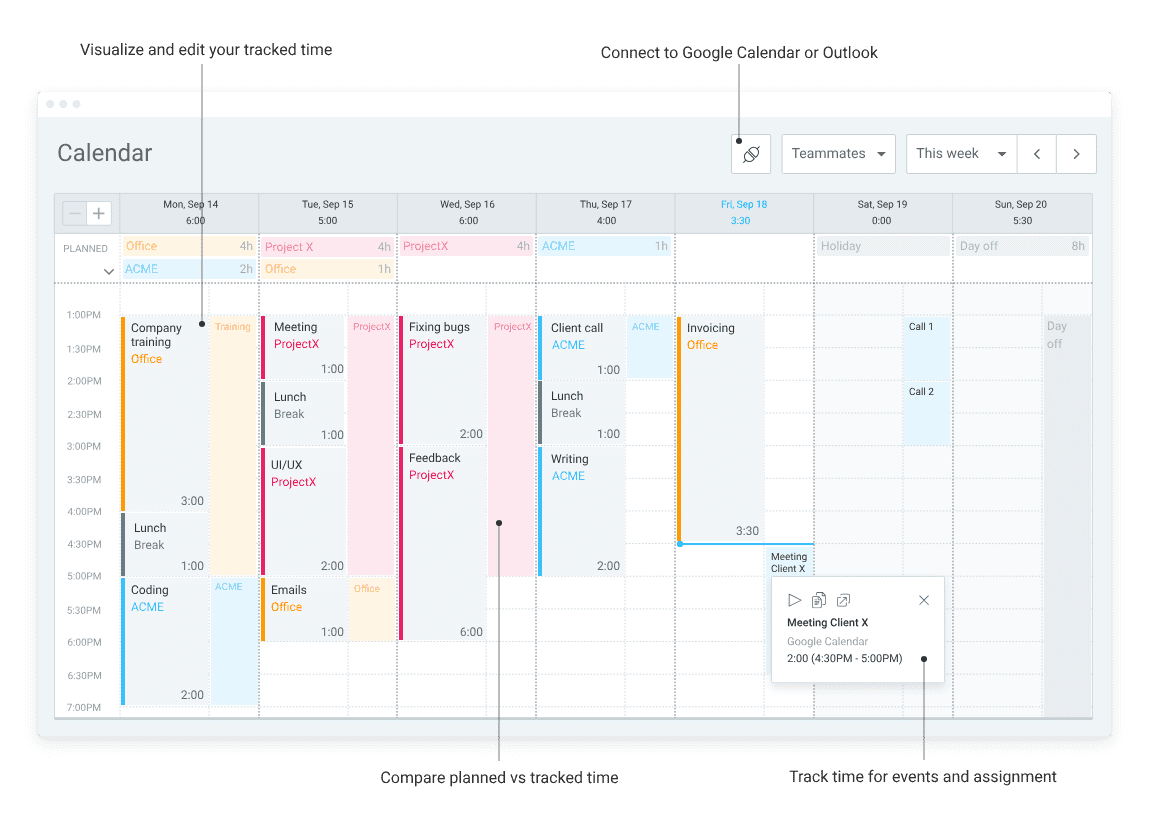
In other words, you can pin down areas where your underperforming coworkers need to step up. For example, suppose they need 2 hours to get a task done, although everyone else needs 1 hour to complete it.
With Clockify’s Calendar, you can assign 2 hours and try to get immediate feedback from the employee during task execution: What are they struggling with and why? How can you help them improve task execution?
If you don’t need to view the whole calendar, you can zoom in and see time entries in 5, 15, 30, or 60-minute time blocks.
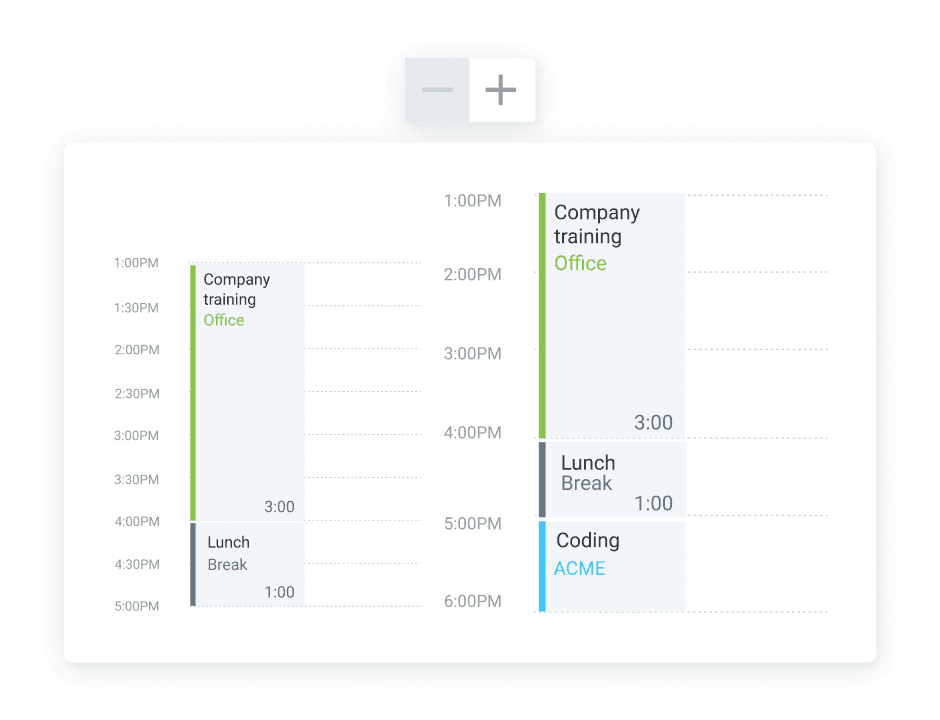
All this information gives you a better idea of how to rate your employee’s performance. In other words, you’ll know how much everyone’s contributing to the company’s bottom line — including underperforming colleagues.
In fact, this makes for a more transparent work environment, where managers and employees are kept in the loop on ongoing projects and issues.
Finally, your underperforming employees need to step up their game. But you can make that process fairer with real-time insights and data-driven decisions.


